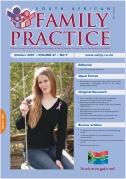Assessing and Serving Families and Communities Responsibly: Challenges Posed in an Urban, Marginalised Setting
Keywords:
Converging interventions, community family therapy
Abstract
Background Service provision to families and communities has long been recognised as a complex undertaking involving a multiplicity of role players and systems of care. Systems theory and ecological theory provide useful frameworks for understanding and servicing families and communities, yet there is a clear absence of literature and research on how to converge microsystemic with macrosystemic interventions. Methods Using Rojano’s community family therapy model, which is applicable to South American communities, and Kasiram and Oliphant’s strategies for changing traditional family therapy to suit broader contexts in South Africa, the authors used developmental research within a qualitative framework to develop an indigenous community family therapy model in an urban setting in KwaZulu-Natal, South Africa. The authors utilised nursing students as fieldworkers and service providers in this study. The research process involved several steps: a state-of-the-art review of the family and community, achieved through an assessment of the family and community through community profiling and an epidemiological study of the community; family assessment of families with one child under the age of five years; best practice and model development to intervene at the family and community levels, achieved with the help of community and school meetings and workshops to identify and prioritise needs and problems, followed by bio-psychosocial interventions; refining the model achieved by an evaluation of the interventions through report assessment and on-site assessment and recommending model adjustments based on the evaluation. Results In designing a community family therapy model, the state-of-the-art review of community needs established several core issues requiring services/interventions. These were problems relating to HIV/AIDS; a lack of knowledge of the immunisation programme in South Africa and of the Road to Health chart; teenage pregnancy and its relationship to risky behaviours, HIV/AIDS, poverty and crime; and a lack of communication within the family. The development of the model involved determining interventions with families and the community, using macrosystemic approaches, such as community meetings and workshops, where priorities were established and joint strategies were planned to address the identified problems. Individual and small-group discussions enriched the understanding of problems/needs, which, combined with macrosystemic approaches such as media coverage and community meetings and workshop/events, worked in synchrony to effectively assess and then service the families and communities. The goal of developing a community family therapy model was achieved. Conclusion Combining microsystemic and macrosystemic approaches to assess and serve families and communities is particularly helpful in the face of apathy. However, once momentum is achieved in securing a community spirit, it needs to be sustained or else it is lost and may require more effort to reclaim in the future. Thus, if services are provided by educational institutions, it would be in the best interests of both future students and the community if there is funding to support service outside of the academic year.
Published
2007-10-18
Section
Forum
By submitting manuscripts to SAFP, authors of original articles are assigning copyright to the South African Academy of Family Physicians. Copyright of review articles are assigned to the Publisher, Medpharm Publications (Pty) Ltd, unless otherwise specified. Authors may use their own work after publication without written permission, provided they acknowledge the original source. Individuals and academic institutions may freely copy and distribute articles published in SAFP for educational and research purposes without obtaining permission.

